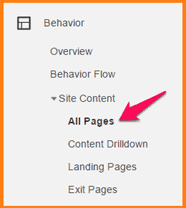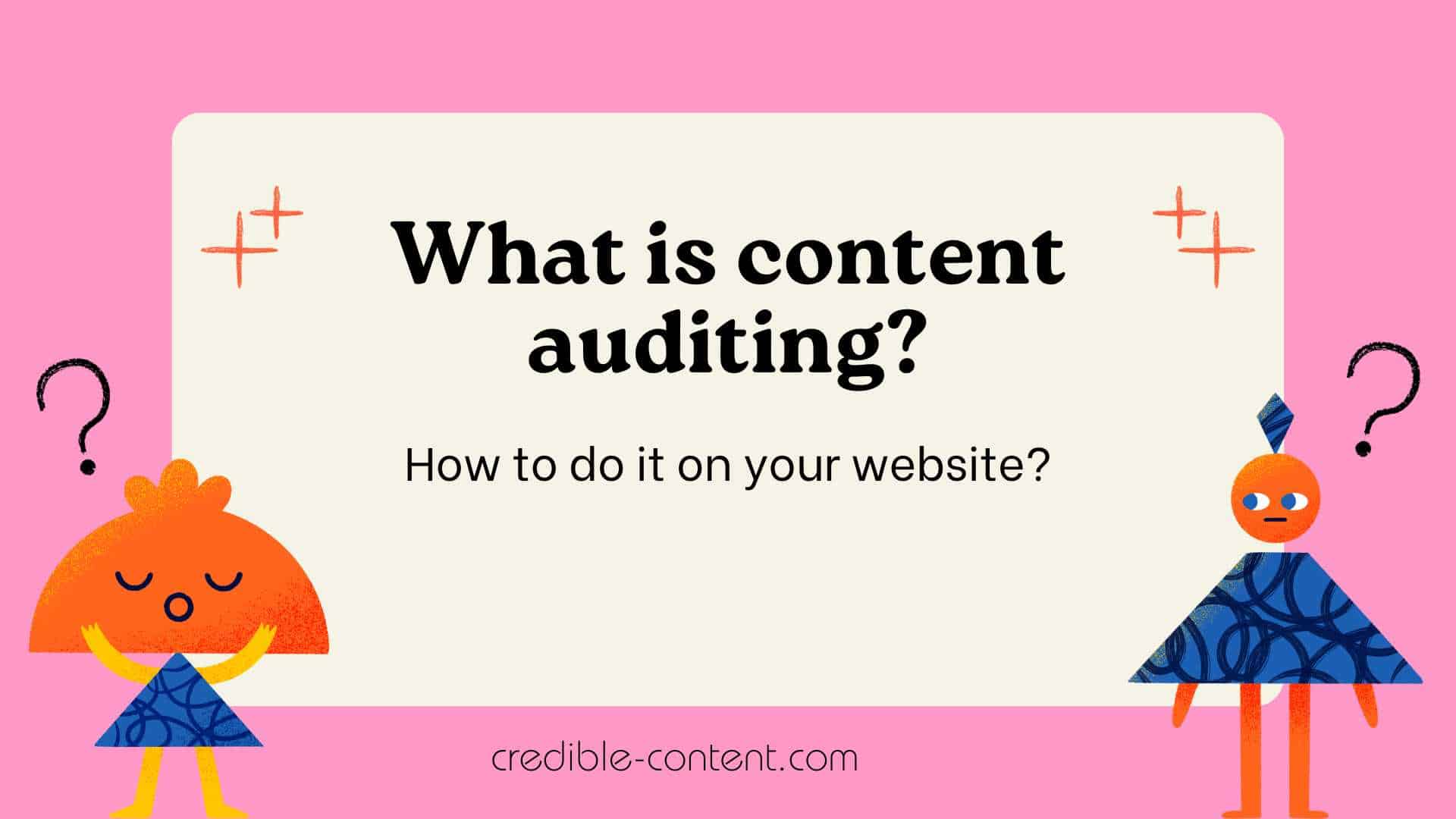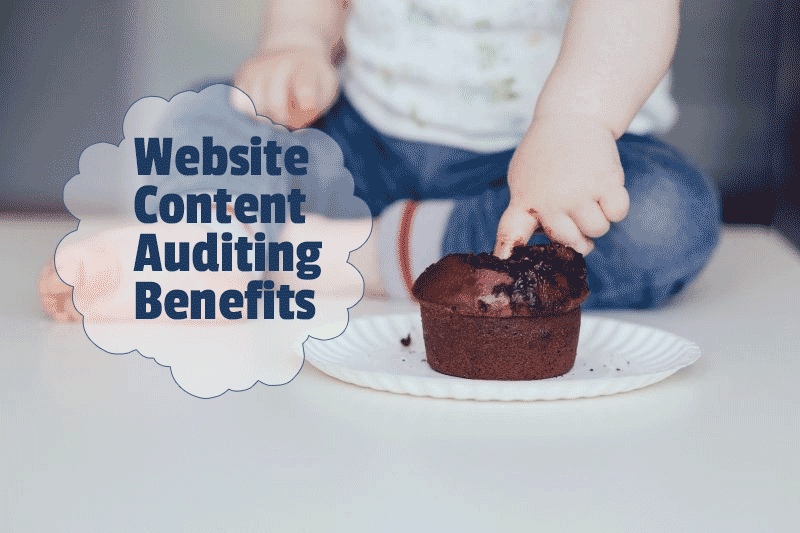Surprisingly, very few businesses and individuals realize the overwhelming benefits of auditing website content regularly. A big reason is that content isn’t yet considered as a valuable asset. It simply exists because, well, every website needs some text, some images and in many cases, some videos.
Or, people get website content for better search engine rankings. They hire an SEO writer or a regular content writer, get content written for their chosen keywords and search terms, and then move on. End of the story.
They don’t realize that they need to audit their website content regularly. Just like they need to take care of other business assets like machines, software applications, computer hardware, stationery and even human resources, they need to take care of their website content. They need to make sure that it is up-to-date, relevant and topical.
What is content auditing and how to do it on your website?
Content auditing means going through your existing content and streamlining it according to your content marketing needs.
You have been publishing a business blog for many years now, right? Even if not a blog, you must have created many webpages for your business website in order to describe your various products and services.
You have your homepage.
Then there is a company profile.
Even an FAQs section.
You may also have the testimonials page.
And maybe many more pages talking about various aspects of your business and the sort of projects you have undertaken.
The basic point is, there might be lots of existing content that needs to be revamped.
Content auditing means creating a list of things that you need to do in order to bring your existing content up to the mark.
Is content auditing needed for every website and blog?
It depends.
If you have always been careful about your content, then perhaps you don’t need content auditing.
The need arises when you have been creating content without paying much attention to exactly what you are trying to achieve, what sort of audience you are trying to target and what sort of results you are striving for.
If you take your content marketing seriously it doesn’t matter whether you have 5 pages, 50 pages or 500 pages, you need content auditing.
Unless you have audited your existing content, you cannot claim to be taking your content marketing seriously.
Is there a precondition to auditing your content?
Totally understanding your content marketing is a precondition to auditing your existing content.
For this purpose, documenting your content marketing strategy is of extreme importance because once you have started documenting your thoughts you know
- What sort of audience you’re going to target
- What sort of content you’re going to produce and distribute in order to target that particular audience
- Which content distribution channels you’re going to use
Once you know what sort of content you need in order to make your content marketing effective you know what changes to carry out in your existing content.
What is the procedure of carrying out a basic content audit of your website?
What you need:
- Google Analytics
- A Spreadsheet Tool (Microsoft Excel, Google Docs or Zoho)
Although you can do content auditing on your website without using any tools, if you have got many pages and blog posts, using tools definitely helps and it also gives you a sense of things that need to be done.
You can begin with Google Analytics.
Of course, if I suggest Google Analytics I assume that you have been using its tracking script on your website for some time and there is sufficient data in your Google Analytics dashboard to give you a picture of what sort of traffic your website is getting.
What if you don’t use Google Analytics?
Install the script onto your website and let it gather some data for at least a month.
Assuming you have some data in your Google Analytics account, go to the website that you need to audit (in case you are tracking multiple websites from your account). On the left-hand side, you need to go to the following section:

This will give you a list of the page views of all the pages.
If your pages are arranged in descending order, you will be able to see which pages are getting the maximum traffic on your website.
These are the pages that you need to audit first.
In the “Page” column click the pop-up window link:

The page will open in a new window from where you can get the URL and then copy/paste the URL in the Excel sheet.
This way, one by one, you can transfer all the URLs to the Excel sheet. Mind you, if you have many URLs it may take lots of time so if possible, get someone else involved.
Once you have transferred all the URLs to your Excel sheet, you can start auditing them one by one. Again, it makes sense to audit the content of those pages that get the maximum page views.
Here are a few things you can change while auditing individual webpages and blog posts:
The web page title
Your web page title should preferably contain your primary keywords and it should be within the recommended length.
For example, the Yoast SEO plug-in suggests that your title should not contain more than 70 characters.
Remember that it is your web page title or your blog post title that people see appearing as a hyperlink on search engine result pages and even on social networking websites updates.
Make your web page title compelling enough.
The web page description
The description of your web page must be around 157 characters.
Try to include your main keywords in the beginning of the description but make your description, logically, is as descriptive as possible.
The body text
Is your body text over-optimized?
Is it under-optimized?
Is there too little text on the web page or blog post?
Can you include more links to other pages?
Can you create more sections?
Can you describe your products or services in a better manner?
Is your content badly written?
Are there typos, spelling mistakes in grammar mistakes?
The use of keywords
No matter what people say, the keywords still matter.
So keep your list of keywords nearby while auditing your content.
Make sure that your primary and secondary keywords are used in the body text strategically.
Create multiple sections under headings and subheadings and make sure that these headings and subheadings contain your keywords.
Create bulleted lists and make sure that these bulleted lists contain your keywords (at least a couple of times).
Use your keywords in the hyperlinks.
Make sure you don’t over-use your keywords.
The most important thing is readability and quality of your content.
Alt tags for your images
Alt tags are very important – to make your website and blog more accessible to people with visual impairments, and also to tell search engines what these images contain.
If you have omitted including alt tags with your images, now is the right time to go through all the images and add alt tags, while you are auditing your content.
Interlinking of webpages and blog posts
Interlinking means linking to webpages and blog posts that add more value and description to your existing web page or blog post.
Suppose I’m writing this about content auditing.
Above, I have mentioned that in order to audit your content, you also need to document it.
Recently I wrote a blog post documenting your content marketing strategy, which is a totally different topic.
So instead of explaining it again, I have simply hyperlinked to it.
It is not just good for usability, it also directs the search engine crawlers to this link in case this link hasn’t been crawled yet.
When the search engine crawlers crawl your links, they also crawl the links present on those links.
Auditing your existing content can be a lengthy process so be mentally prepared for it.
It is not something that you can do in a day or two.
If there are 100s of pages of content on your website or blog, you may need months to go through individual links and audit them.
You may also need to hire external help.
Go ahead, do it. Before you hire a content writer to write new content for you, it’s better to hire someone to audit your existing content first.
6 ways to audit your content

From time to time you should audit your existing content.
You don’t always have to write new content because after a while, it is difficult to come up with original and compelling content writing ideas.
I’m not saying that you altogether abandon the thought of publishing new and original topics, but you can make a mix of new content and existing content and keep on giving fresh content to Google.

Google doesn’t like stale content.
It can make out if you posted something a year ago and ever since then you haven’t updated it or refreshed it.
Auditing your existing content allows you to do that.
What does auditing mean?
Auditing doesn’t just mean updating your existing content (web pages and blog posts, and sometimes even videos and images, that you have already published).
It means individually going through different pieces of content and analysing them to find out whether they are still relevant or not or whether they’re solving the purpose for which they were originally created and published.
Auditing is an exercise that is carried out to find whether something complies with conditions or parameters for which that thing was created.
In terms of your existing content, you may want to find out
- Does it enjoy higher search engine rankings for relevant keywords?
- Was it fully optimized or is there still some scope for optimization?
- Does the content need to be rewritten because in its current state, it doesn’t read well?
… so on and so forth.
You may like to read Improve your SEO with content auditing that I published just a few weeks ago.
As I have mentioned in the above-linked post, while auditing I was trying to find out whether my web pages are search engine optimized or not, and if not, using the SEOPressor plug-in I have been trying to optimize them.
Along the way I have learnt something else and hence, changed my approach, but that’s another topic.
This Content Marketing Institute blog post suggests 6 questions that you should ask yourself to be able to audit your existing content meaningfully.
To be able to properly audit your existing content, the CMI blog post suggests that you should ask the following questions:
- Is the content still relevant?
- How many people visit the post?
- What engagement is the post receiving?
- How strong are the SEO indicators?
- Is the post converting?
- What content is missing?
Let’s quickly go through these questions and try to find some brief answers.
Is the content still relevant?
Your content grows old.
This is especially applicable to those blog posts and web pages that were relevant to the time during which they were created.
Remember there used to be a time when getting featured on the homepage of Digg used to be a big thing, to the extent of launching new businesses with just a single instance of getting featured?
Prolific Diggers were in big demand and sometimes they were paid heavily just to share links among themselves.
What about StumbleUpon?
Just as we have share buttons for Twitter, Instagram, LinkedIn and Facebook, we also used to have share buttons for Digg and StumbleUpon.
Now, these two services are almost gone. As websites they may exist, but very few people know about them or care about them.
So, if you have written a blog post on how to promote your content on social media and you have taken these content sharing platforms as one of your central points, you may want to revisit your blog post and make it more relevant by removing what is not used these days and adding what is used.
Maybe Instagram didn’t exist at that time but now it’s a big thing. So, you can replace StumbleUpon with Instagram and write something about it.
Similarly, if you think there are some issues that were relevant in 2008 but are not relevant now, you can rewrite those blog posts and web pages to make them relevant and then resubmit them to Google as fresh content.
How many people visit the post?
Google Analytics can tell you that.
GA, through appropriate filtering, can tell you how many visitors you are attracting from Google and other search engines and how many from social networking websites, or even directly from other websites and blogs.
For some web pages and blog posts, you don’t want the traffic to go down.
For example, Website Content Writing Services is one of my main web pages and I don’t want its traffic to go down no matter how old it becomes.
I should regularly audit this page and keep a tab on what type of traffic it is attracting and then make changes accordingly.
What engagement is the post receiving?
What is engagement vis-à-vis the relevance of your content?
The engagement level tells you how important or relevant people find your content.
Are they still sharing it?
During the past month, how many people have shared this particular piece of content, let’s say, on Facebook, LinkedIn or Twitter?
How many comments has it generated?
How many times has it been shared on various social media and social networking websites?
How much time are people spending on this blog post and what is its bounce rate?
Then, if this piece of content is found wanting, you can take appropriate steps to make improvements.
How strong are the SEO indicators?
As I mentioned in my own blog post on content auditing, I have been reviewing my individual web pages for SEO indicators or to find out how well they have been optimized.
The SEOPressor WordPress plug-in that I have installed on my website and my blog immediately tells me my SEO score.
The SEO indicators may include:
- The presence of your primary keywords and phrases in your blog post or web page title.
- The presence of your primary keywords and phrases in your blog post and web page description.
- The ALT text of your images.
- The number of images in the blog post.
- Keyword density (under-optimized or over-optimized).
- Content length (the more the merrier, preferably more than 1200 words).
- The readability score.
These indicators tell you how well you have optimized your existing content.
Is the post converting?
Different blog posts and different web pages may have different metrics for measuring conversion.
For example, the purpose of your blog post might not be increasing your sales.
It can be getting more subscriptions for your newsletter or encouraging more people to download your e-book or increase your social media engagement (how many people are sharing this blog post or web page).
Again, in Google Analytics you can set conversion goals and track the conversion rate of your individual blog posts and web pages and if you think that certain blog posts and web pages are not converting well, you can make changes as you deem fit.
What content is missing?
Sometimes you want to incorporate more keywords. For example, the SEOPressor WordPress plug-in allows you to optimize your content writing for three keywords or search phrases.
To accommodate extra keywords and phrases you may like to add more content.
Is auditing your existing content absolutely necessary?
If your content matters, if content marketing matters, then I must say, it is important.
Whether it is absolutely necessary or not depends on your ambition and your ability to take care of your content assets.
The more blog posts and web pages you have, the harder it is to audit repeatedly.
It is always better to have a dedicated content writer, or even a team of content writers who regularly audit your existing content.
If this is something you cannot afford right now, then there is a big chance you don’t even have those many blog posts and web pages.
It means your existing content can be audited within a week or two and you can hire someone for that period, or if you have time, you can audit yourself.
Why does a website audit seem like a daunting task?
We like new things. New things are full of possibilities. New things are free of judgments. This is why we continuously want to create and publish new content while totally disregarding existing content.
Another reason why a website audit may seem like a daunting task is that normally there are too many web pages and blog posts to audit.
If you have been publishing content, in whichever manner you have been publishing it, over a period of years, you must have published hundreds of them. As you publish more, their number increases.
So, the mere thought of revisiting all those web pages and blog posts that you have published over all these years seems daunting. You know that it may take weeks, even months, to audit all those web pages and blog posts.
Undoubtedly, the process can be tedious and time-consuming. But given the fact that it can tremendously improve your organic search engine rankings and on-site conversion rate, not auditing your website content is a big waste of the opportunity that is lying right in front of you. You need to take the plunge. The benefits overwhelmingly outweigh the effort involved.
How to kickstart your website content auditing plan?
First of all, you have to get hold of all the URLs present on your website. If you are using WordPress to manage your website or blog, you can use a plug-in that exports all the URLs onto a web page or into a comma separated file.
For a non-WordPress website, you can try the various URL crawling tools available on the Internet.
Then you can save these URLs into a spreadsheet.
In WordPress, there is also a plug-in that gives you a ready-made interface for content auditing but I prefer tracking your auditing progress in a spreadsheet because it is more flexible and you don’t have to install a dedicated plug-in for that.
Although you may have your own way of organizing data in your Excel sheet, I prefer that for every auditing exercise you create a separate worksheet in a single spreadsheet. For example, if you decide to start your content auditing in January 2018, you can have a “January 2018” worksheet.
In this worksheet you can have the following columns:
- URL title (page title or blog post title)
- Complete link
- SEO keywords – keywords for which this particular link should be ranking high or is already ranking high
- Conversion goal – why was this webpage or blog post created
- Suggested changes – more content to be added, more optimization to be incorporated, old information to be updated, more or new images to be added, SEO tweaks to be done, and so on
- Audit status – to be audited, being audited or audited, or whatever
- Audit date – when the current audit is complete
- Recheck date – decide the date on which you should check whether the changes that you have made are showing up or not. For example, whether this link is ranking for the right keywords or not or whether its conversion rate has improved or not
Having such a spreadsheet will allow you to track individual links, and also their progress.
If multiple employees or multiple content editors will be working on your content auditing project, you can also have another column titled “Assigned to” where you can put the names of people responsible for that particular link.
5 benefits of auditing your website content
Benefits are a great motivation. Unless you understand the true motive of a thorough website content audit, you won’t be able to carry it out in its true spirit.
Listed below are 5 benefits of auditing your website content:
1. Make your content up-to-date
Are you still giving examples of MySpace and Google Wave? Are you still suggesting your clients to blog using Blogger.com? Are you still giving examples from companies that no longer exist? Is one of your web pages still telling people that Obama is the President? Is your web page copy still making references to Blackberries?
Then it’s time to update your content. The world these days changes very fast. The information that you used a couple of years ago doesn’t matter. The business tools you referred to 5 years ago are no longer available or they have gone through monumental changes.
2. Resubmit to Google
When was it the last time Google crawled and indexed your important links? Although most of the search engine crawlers do this automatically, you are never sure when your website’s turn is going to come.
When you audit your website content and make changes you can manually resubmit your link through the Google search console. This shouldn’t be done without making changes because if you try to submit content that has already been indexed, Google begins to ignore your resubmission requests.
3. Optimize your content for targeted keywords
Perhaps originally when you were creating/writing your content you didn’t pay much attention to its optimization aspect. Maybe now you have gained more experience. Your new links are faring well. You can use that experience to optimize even the older links.
Or maybe you have over optimized.
The Google ranking algorithm has gone through many changes over the years and SEO practices that were legit 5-6 years ago can get your content penalized now.
Maybe you have, unintentionally, overused your keywords. Maybe you have done lots of interlinking. Maybe you have used some black hat SEO tactics to gain better search engine rankings – back then you didn’t know that those were black hat SEO tactics.
Recently when I was auditing my own website content I realized that on many web pages I had stuffed my content with keywords even without realizing it. A few changes, some inclusion of LSI keywords, and suddenly my rankings began to improve for the same keywords.
4. Improve the overall quality of your content
Maybe you hired an ill-trained content writer back then because of budgetary constraints. Or you didn’t have much time to pay enough attention to the quality of your content.
When you audit your website content – provided you have assigned enough time to it – you get the opportunity to improve the overall quality of your content.
You can take care of grammar and spelling mistakes. You can simplify over-complicated sentences. You can organize various bits of content under headings, sub-headings and bullet points. You can link to other web pages and blog posts that can provide additional information.
You can also update the images. Is there a scope that you can reduce the size of the images? Can you use better images? Did you forget to insert the ALT tag information the first time?
5. Get new content ideas out of existing content
Getting new content ideas on an ongoing basis can be a big problem. Around 60% of content marketers re-purpose existing content. According to statistics present on this Smart Insights blog post, 60% content marketers find it very difficult to publish engaging and good quality content on an ongoing basis.
You may also like to read 15 ways you never run out of blogging ideas.
So, these are the 5 basic benefits of auditing your website content on a regular basis.
How regular you want to be, depends on your content marketing strategy, your budget, and the resources that you can employ to audit your existing content.
Having said that, auditing doesn’t always mean you need to change every single web page or blog post. You can also quickly check whether a particular link needs to be updated or not and you can leave it as it is if it does not need any sort of update.





